A Scorecard for Humanity: Air Pollution, Hutton
Assessment Paper
A version of the working paper is available for download here. The finalized paper has been published in How Much Have Global Problems Cost the World? A Scorecard from 1900 - 2050 by Cambridge University Press.
By Guy Hutton and released as a chapter in How Much Have Global Problems Cost the World?

The biggest environmental problem in the world is, perhaps surprisingly, air pollution. Perhaps even more surprisingly, it has been declining for past 110 years. This is because most air pollution deaths are caused by indoor pollution from cooking and heating with dirty fuels. Over the 20th century, 260 million died from indoor air pollution in the Third World – about twice the toll in all the century’s wars. This is more than 4 times more than died from outdoor air pollution. As poverty has receded and clean fuels gotten cheaper, the risk has fallen eight-fold and will decline another 70% until 2050.
Short summary
Air pollution is a problem as old as history itself. Air pollution can be defined broadly as the introduction of chemicals, particulate matter, or biological materials into the atmosphere that cause harm or discomfort to humans or other living organisms, or cause damage to the natural environment or built environment. Air pollution can be classified into anthropogenic and non-anthropogenic origin. The latter includes natural events such as wildfires, volcanic activity and dust/sand storms. This source of air pollution is not considered in this chapter as it is largely context-specific, and since the year 1900 is likely to be relatively unimportant compared with air pollution of anthropogenic origin.
Anthropogenic, or man-made, air pollution can be traced back to when humanity discovered how to make fire. While air pollution in those days was insignificant compared to the present time, burning biomass in enclosed spaces for space heating or for cooking purposes would have exposed humans to risk of respiratory diseases and injuries. As human populations became settled and increasingly burned biomass and fossil fuels (such as coal) indoors, the exposure to air pollution and its negative consequences rose significantly. Annex 1 shows the percentage of populations in developing countries burning solid fuels indoors, ranging from 16% of households in Latin America and the Caribbean and Central and Eastern European regions, to 74% in Southeast Asian and Western Pacific regions and 77% in Africa.
Man-made outdoor air pollution, on the other hand, only became a health issue much more recently. The industrial revolution - which began in Great Britain and spread to the rest of Europe, the USA and Japan in the 18th century – increased significantly the combustion of biomass and fossil fuels in urban centers, leading to dangerously high levels of air pollution. Pollutants can be classified as primary or secondary. Primary pollutants are directly emitted from a process, such carbon monoxide gas from a motor vehicle exhaust or sulfur dioxide released from industrial processes. Secondary pollutants such as ozone (O3) and particulate matter (PM) are not emitted directly, but form in the air when primary pollutants react or interact. Air pollution statistics in urban areas are available from various sources by country or by city, but not compiled globally. Air pollution maps and monitoring information are available from various internet sources.
Air pollution’s impacts are both direct and indirect. Direct impacts include health, damage of materials and ecosystems, and poor visibility. Less direct impacts include ‘acid rain’ which results from chemicals being released into the atmosphere. Changes in human behavior also result from air pollution, such as inhabitants of heavily polluted urban areas relocating or tourists staying away from polluted cities. The main indirect impact is climate change. The biomass and fossil fuels that cause air pollution also have caused the warming of the earth’s atmosphere resulting from the release of greenhouse gases (GHGs). Therefore, air pollution has many and diverse impacts.

